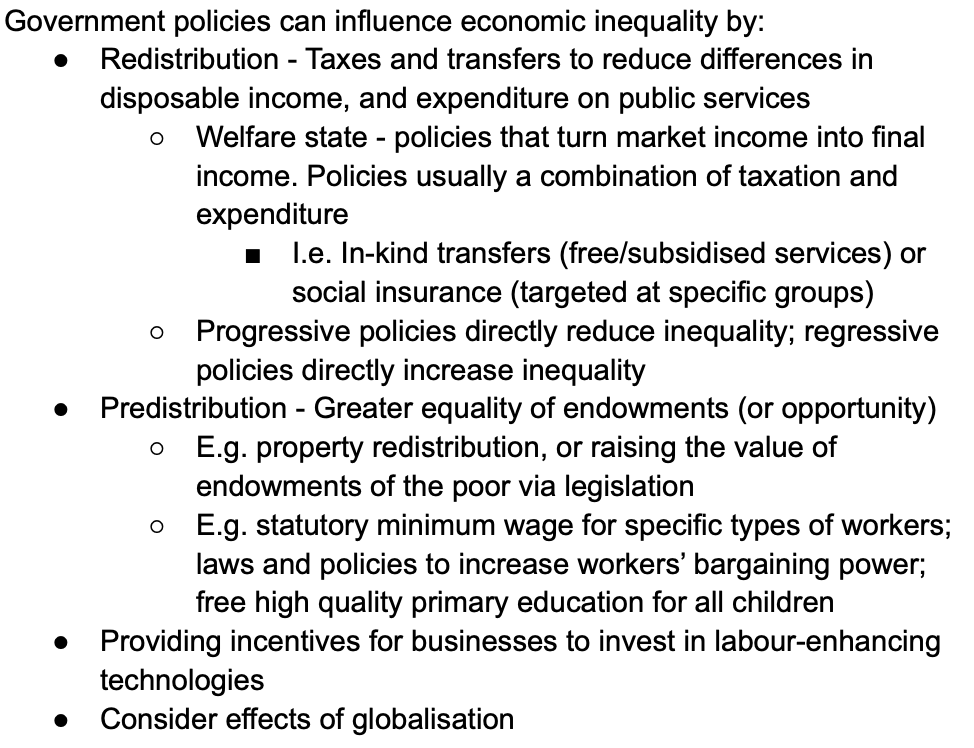TRENDS in economic inequality - ECO1016
1/17
Earn XP
Description and Tags
Historic Trends
Name | Mastery | Learn | Test | Matching | Spaced |
|---|
No study sessions yet.
18 Terms
The trend in global inequality from 1820-1910, and its status thereafter
Rose until 1910, then stabilised at a high level
Top 10% of income earners share of global income
Around 50-60% of global income
Bottom 50% of income earners share of global income
Around 5-15% of global income
Bottom 50% of share of global wealth
Around 2% of global wealth
Since 1980, how inequality within and between countries has trended
Inequality within countries has increased, but inequality between countries has decreased
The difference in distributions of wealth, market income (wages, businesses, and investments), and disposable income (market income + transfers - taxes)
Wealth is much more unequally distributed than market income, which is more unequally distributed than disposable income
Trend in income inequality in Great Britain in the 1980s (under Thatcher)
Income inequality increased significantly. The Gini rose from 0.26 in 1980 to 0.34 by 1990. The 90:10 household income ratio rose from 3.2 to 4.4 over the same period.
Due to:
mines closing and high skill jobs rising
weaker trade unions
regressive tax and benefit policy change
The 90:10 ratio in Great Britain in 2020
Roughly 4, the richest 1% earning 4 times the poorest 10%
Trends in inequality since the 1990s in Great Britain
Inequality fell and incomes grew until the Great Recession (2007-09), income inequality fell further and more progressive tax and benefit policies were enacted.
In the 2010s, fiscal austerity led to incomes at the bottom of the distribution falling, while earnings and hours worked rose
Structural change (manufacturing vs service sector) in the Great British economy since 1980
The service sector has overtaken manufacturing, which used to provide high and equally paying jobs.
The service sector offers low skill low wage jobs and high skill high wage jobs, but low wages have remained stagnant while high wages have increased rapidly.
This has contributed to the North being generally worse off than the South (especially London)
Impact of automation (machines and software) on income inequality (in the US) (researched by Daron Acemoglu)
Automation replacing humans with machinery has meant labour productivity stagnated, rather than becoming more productive.
Lesser educated males have had jobs disappear, the remaining jobs offer lower real wages.
Automation is responsible for more than 50% of the increasing wage gap between US workers, tax policies have incentivised this investment in automation
Addressing Inequality

Educational attainment in recent decades
Increasing, both school level and higher level qualifications
More higher education degrees, and less lowest level qualifications
Trend in skill attainment across generations in England
Despite rising qualifications, skills have not improved
Parents and their children have similar literacy levels, social mobility lacks
Public spending on education in since 1960 (UK)
Rising in real terms except for the 2010s austerity, where per pupil spending decreased
In real terms, colleges and sixth forms would still have lower funding in 2024 than 2010 (due to the austerity lowering)
Relationship between education and earnings
Mathematically plotted by the mincer equation, regressing wage earnings on education and experience.
A positive relationship.
Hard to disentangle which part of earnings are caused by skills and knowledge gained from higher education, and which part is due to academic ability.
Who gains the most from higher education? (gender, ethnicity, family background, subjects, schools attended previously)
Women
Women of a South Asian background
Men from the poorest and richest quintiles
Economics and medicine graduates
Privately educated graduates
Social mobility in education (how much does your background affect your returns on education, or educational attainment)
Children from disadvantaged backgrounds obtain lower qualifications, preventing them moving above their family background. But they gain high returns.